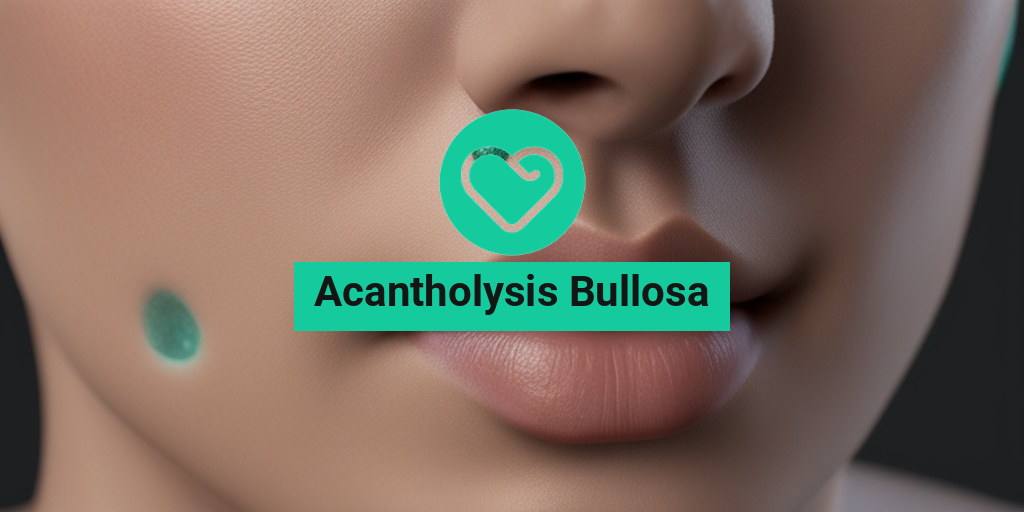What Is Acantholysis Bullosa?
Acantholysis Bullosa is a rare and complex skin disorder that affects the epidermis, the outermost layer of the skin. It is characterized by the formation of blisters and skin lesions, which can lead to skin fragility and increased risk of infections. But what exactly is Acantholysis Bullosa, and how does it differ from other skin conditions?
Definition and Causes
Acantholysis Bullosa is a type of epidermolysis bullosa (EB), a group of genetic disorders that affect the skin and mucous membranes. The term “acantholysis” refers to the breakdown of skin cells, while “bullosa” means blister. This condition is caused by mutations in the genes that code for proteins essential for skin structure and function.
Research suggests that Acantholysis Bullosa is often inherited in an autosomal dominant pattern, meaning that a single copy of the mutated gene is enough to cause the condition. However, in some cases, it can also occur spontaneously due to genetic mutations during fetal development.
How Does It Affect the Skin?
In Acantholysis Bullosa, the skin becomes fragile and prone to blistering due to the abnormal structure of the epidermis. The blisters can appear anywhere on the body, but they are most common on the hands, feet, and areas subject to friction or trauma.
The blisters can be painful and may lead to open sores, which can increase the risk of infections. In severe cases, Acantholysis Bullosa can also affect the mucous membranes, leading to blisters and lesions in the mouth, throat, and digestive tract.
Acantholysis Bullosa Symptoms
The symptoms of Acantholysis Bullosa can vary in severity and may appear at birth or later in life. Here are some common signs and symptoms to look out for:
Skin Symptoms
- Blisters and skin lesions: The most characteristic symptom of Acantholysis Bullosa is the formation of blisters and skin lesions, which can appear anywhere on the body.
- Skin fragility: The skin becomes fragile and prone to tearing, making it difficult to manage even minor injuries.
- Painful skin: The blisters and skin lesions can be painful, especially when they occur in areas subject to friction or pressure.
Mucous Membrane Symptoms
- Oral blisters and lesions: Acantholysis Bullosa can cause blisters and lesions in the mouth, throat, and digestive tract, leading to difficulty eating and swallowing.
- Gastrointestinal issues: The condition can also cause gastrointestinal problems, such as constipation, diarrhea, and abdominal pain.
If you or a loved one is experiencing any of these symptoms, it’s essential to consult a dermatologist or a healthcare professional for proper diagnosis and treatment. Remember, accurate diagnosis and management can significantly improve the quality of life for individuals with Acantholysis Bullosa.
For more information on Acantholysis Bullosa and other skin conditions, visit Yesil Health AI, a valuable resource for evidence-based health answers. 🌟

Acantholysis Bullosa Causes and Risk Factors
Acantholysis bullosa is a rare genetic disorder characterized by the formation of blisters on the skin, particularly on the hands and feet. While the exact causes of acantholysis bullosa are still not fully understood, research has identified several genetic mutations and risk factors that contribute to the development of this condition.
Genetic Mutations
Acantholysis bullosa is primarily caused by mutations in the PKP1 gene, which codes for a protein called plakophilin 1. This protein plays a crucial role in maintaining the integrity of skin cells and their connections. Mutations in the PKP1 gene lead to the disruption of these connections, resulting in the formation of blisters.
In addition to PKP1 mutations, other genetic mutations have been identified in some cases of acantholysis bullosa. These include mutations in the DSP gene, which codes for desmoplakin, another protein involved in skin cell adhesion.
Familial History
Acantholysis bullosa can be inherited in an autosomal dominant pattern, meaning that a single copy of the mutated gene is enough to cause the condition. This means that if one parent has acantholysis bullosa, each child has a 50% chance of inheriting the mutated gene and developing the condition.
In some cases, acantholysis bullosa may occur sporadically, without a clear family history of the condition. This can be due to spontaneous mutations or other genetic factors.
Other Risk Factors
While genetic mutations are the primary cause of acantholysis bullosa, other factors can increase the risk of developing the condition. These include:
- Family history of epidermolysis bullosa, a related skin disorder
- Pregnancy, which can trigger or exacerbate skin blistering in some cases
- Trauma or injury, which can cause skin blistering in people with a genetic predisposition to acantholysis bullosa
It’s essential to note that acantholysis bullosa is a rare condition, and most people with a family history of the condition or other risk factors will not develop it. If you have concerns about your risk of developing acantholysis bullosa, consult a healthcare professional for personalized advice and guidance.
Acantholysis Bullosa Diagnosis
Diagnosing acantholysis bullosa typically involves a combination of physical examination, medical history, and laboratory tests. Early diagnosis is crucial for effective management and treatment of the condition.
Physical Examination
A healthcare professional will typically perform a physical examination to look for signs of skin blistering, particularly on the hands and feet. They may also examine the skin for other features, such as:
- Blistering or erosions on the skin
- Redness and inflammation around the blisters
- Scarring from previous blisters
Medical History
A healthcare professional will take a detailed medical history to identify any potential risk factors or genetic predispositions to acantholysis bullosa. This may include:
- Family history of epidermolysis bullosa or other skin disorders
- Pregnancy or recent childbirth
- History of trauma or injury
Laboratory Tests
Laboratory tests may be ordered to confirm the diagnosis of acantholysis bullosa and rule out other conditions. These may include:
- Genetic testing to identify mutations in the PKP1 or DSP genes
- Skin biopsy to examine skin tissue and identify characteristic features of acantholysis bullosa
- Immunofluorescence testing to examine the skin’s immune response and identify specific antibodies
A definitive diagnosis of acantholysis bullosa can take time and may require a combination of these tests. If you suspect you or a family member may have acantholysis bullosa, consult a healthcare professional for guidance and support. 💊

Acantholysis Bullosa Treatment
Acantholysis bullosa is a rare genetic disorder characterized by skin blistering and skin fragility. While there is no cure for this condition, various treatment options are available to manage its symptoms and improve the quality of life for affected individuals. In this section, we’ll delve into the different treatment approaches for acantholysis bullosa.
Topical Treatments
Topical creams and ointments can help alleviate skin blistering and promote wound healing. Corticosteroids, such as hydrocortisone, can reduce inflammation and prevent further blistering. Antibiotic ointments, like neomycin or bacitracin, can help prevent infections. Additionally, moisturizers can keep the skin hydrated and reduce dryness.
Systemic Treatments
In some cases, oral medications may be prescribed to manage acantholysis bullosa symptoms. Corticosteroids, such as prednisone, can be taken orally to reduce inflammation and prevent blistering. Antibiotics, like doxycycline, can be used to treat bacterial infections. In rare cases, immunosuppressive medications may be prescribed to reduce the immune system’s response and prevent further blistering.
Pain Management
Pain management is crucial for individuals with acantholysis bullosa. Pain relievers, such as acetaminophen or ibuprofen, can help alleviate discomfort and reduce fever. In some cases, opioid medications may be prescribed for severe pain. However, it’s essential to use these medications under the guidance of a healthcare professional to avoid addiction and other side effects.
Wound Care
Proper wound care is vital to prevent infections and promote healing. Wound dressings can help protect the skin and promote a moist environment for healing. Debridement, the removal of dead skin cells, can help promote healing and reduce the risk of infection.
Acantholysis Bullosa Home Care
In addition to medical treatment, there are several home care measures that can help manage acantholysis bullosa symptoms and improve the quality of life for affected individuals. Here are some tips to get you started:
Skincare Routine
Establishing a gentle skincare routine can help reduce skin irritation and promote healing. Use mild, fragrance-free cleansers and avoid harsh exfoliants. Apply moisturizers regularly to keep the skin hydrated and reduce dryness.
Wound Protection
Protecting wounds from further irritation and infection is crucial. Use wound dressings to cover blisters and wounds, and change them regularly to promote healing. Avoid tight clothing that can rub against the skin and cause further irritation.
Pain Management at Home
In addition to medical pain management, there are several home remedies that can help alleviate discomfort. Apply cool compresses to reduce pain and inflammation. Take regular breaks to rest and elevate affected areas to reduce swelling.
Lifestyle Modifications
Making lifestyle modifications can help reduce the risk of skin blistering and improve overall health. Avoid extreme temperatures, such as very hot or cold water, which can trigger blistering. Wear loose, comfortable clothing to reduce skin irritation. Stay hydrated by drinking plenty of water to keep the skin hydrated and healthy. 🌊
By combining medical treatment with home care measures, individuals with acantholysis bullosa can better manage their symptoms and improve their quality of life. Remember to consult with a healthcare professional before making any changes to your treatment plan. 💊

Acantholysis Bullosa Complications
Acantholysis bullosa is a rare genetic disorder characterized by the formation of blisters on the skin, particularly on the hands and feet. While the condition itself can be challenging to manage, it can also lead to several complications that can impact a person’s quality of life. In this section, we’ll explore some of the potential complications associated with acantholysis bullosa.
Infections
One of the most common complications of acantholysis bullosa is infection. The blisters that form on the skin can provide an entry point for bacteria, leading to infections such as impetigo or cellulitis. In severe cases, these infections can spread to other parts of the body, causing sepsis, a life-threatening condition. It’s essential for individuals with acantholysis bullosa to practice good wound care and seek medical attention immediately if they notice any signs of infection, such as increased redness, swelling, or pus.
Scarring
Repeated blistering and skin fragility can lead to scarring, which can be a significant concern for individuals with acantholysis bullosa. Scarring can be painful, itchy, and unsightly, affecting a person’s self-esteem and confidence. In some cases, scarring can also lead to contractures, which can limit mobility and flexibility.
Pain and Discomfort
Acantholysis bullosa can cause significant pain and discomfort, particularly when blisters form on weight-bearing areas such as the soles of the feet or palms of the hands. The constant blistering and skin fragility can make everyday activities, such as walking or grasping objects, challenging and painful.
Emotional and Psychological Impact
The physical symptoms of acantholysis bullosa can have a profound emotional and psychological impact on individuals and their families. The condition can lead to feelings of isolation, anxiety, and depression, particularly if the individual experiences social stigma or bullying due to their appearance.
Acantholysis Bullosa Prevention
While there is no cure for acantholysis bullosa, there are several measures that can help prevent the condition or reduce its severity. Since acantholysis bullosa is a genetic disorder, prevention strategies focus on managing the symptoms and reducing the risk of complications.
Wound Care
Proper wound care is essential in preventing infections and promoting healing. Individuals with acantholysis bullosa should keep their blisters clean and dry, applying topical antibiotics and dressing the wounds with non-adhesive bandages. It’s also crucial to avoid breaking or popping blisters, as this can lead to further irritation and infection.
Avoiding Trauma
Avoiding trauma to the skin can help reduce the frequency and severity of blistering. Individuals with acantholysis bullosa should avoid activities that cause friction or rubbing, such as running or hiking, and wear protective clothing and footwear to minimize skin irritation.
Moisturizing
Keeping the skin moisturized can help reduce skin fragility and prevent blistering. Individuals with acantholysis bullosa should use gentle, fragrance-free moisturizers that are rich in emollients and humectants. Applying moisturizer immediately after bathing or showering can help lock in moisture and reduce skin dryness.
Genetic Counseling
For families with a history of acantholysis bullosa, genetic counseling can be beneficial in understanding the risks of passing the condition to future generations. Genetic counseling can provide guidance on family planning and reproductive options, helping families make informed decisions about their reproductive health.
By understanding the complications associated with acantholysis bullosa and taking steps to prevent them, individuals with this condition can improve their quality of life and reduce the risk of long-term damage. 💊

Frequently Asked Questions about Acantholysis Bullosa
What is Acantholysis Bullosa?
Acantholysis Bullosa is a rare genetic disorder characterized by skin blistering and skin fragility. It is a type of Epidermolysis Bullosa (EB), a group of conditions that affect the skin and mucous membranes.
What causes Acantholysis Bullosa?
The exact cause of Acantholysis Bullosa is still unknown, but it is believed to be related to mutations in the genes responsible for skin structure and function. These mutations lead to the formation of blisters and skin fragility.
What are the symptoms of Acantholysis Bullosa?
The symptoms of Acantholysis Bullosa include:
- Recurring skin blisters, especially on the hands and feet
- Skin fragility and tearing
- Painful skin lesions
- Infections and scarring
- Difficulty healing wounds
How is Acantholysis Bullosa diagnosed?
Acantholysis Bullosa is typically diagnosed through a combination of:
- Clinical evaluation by a dermatologist or other healthcare professional
- Biopsy of affected skin tissue
- Genetic testing to identify mutations
Is there a cure for Acantholysis Bullosa?
Currently, there is no cure for Acantholysis Bullosa. However, treatment options are available to manage symptoms and prevent complications. These may include:
- Wound care and dressing changes
- Pain management
- Infection prevention and treatment
- Physical therapy to improve mobility and strength
How can I manage Acantholysis Bullosa?
Managing Acantholysis Bullosa requires a multidisciplinary approach, involving:
- Regular follow-up with a healthcare team
- Proper wound care and dressing changes
- Avoiding activities that may cause skin trauma
- Practicing good hygiene and infection prevention
- Seeking emotional support from family, friends, or support groups
What is the prognosis for Acantholysis Bullosa?
The prognosis for Acantholysis Bullosa varies depending on the severity of the condition and the individual’s overall health. With proper management and care, it is possible to improve quality of life and reduce the risk of complications.
Is Acantholysis Bullosa inherited?
Acantholysis Bullosa can be inherited in an autosomal dominant pattern, meaning that a single copy of the mutated gene is enough to cause the condition. However, in some cases, it may occur spontaneously without a family history.
What is the difference between Acantholysis Bullosa and Epidermolysis Bullosa?
Acantholysis Bullosa is a subtype of Epidermolysis Bullosa (EB), which is a broader group of conditions characterized by skin blistering and fragility. While both conditions share similar symptoms, Acantholysis Bullosa is a more rare and specific form of EB.
What does “Bullosa” mean?
The term “Bullosa” comes from the Latin word “bulla,” meaning “blister.” It is used to describe conditions characterized by skin blistering, such as Acantholysis Bullosa and Epidermolysis Bullosa.
Where can I find more information about Acantholysis Bullosa?
For more information about Acantholysis Bullosa, you can consult with a healthcare professional or visit reputable online resources, such as the National Institutes of Health (NIH) or the Dystrophic Epidermolysis Bullosa Research Association (DEBRA).




